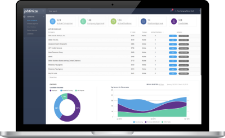Leading edge people practices in a family owned commercial cleaning company
Slashing turnover, boosting productivity, and improving the quality of life for the owners and the staff.
The client is a regional commercial cleaning company on the East Coast, owned and operated by a husband and wife team who at the time was far too deep in the detail of the business. Not by choice, but by necessity.
When they reached out to us in late 2007, they had a long list of concerns – which, if left unresolved, had the potential to cost them the business. The couple were stressed and time-starved, living in reaction mode. Here are some of the symptoms they presented:
- Turnover was steady at 111%
- People would look good in the interview, and then not show up for shifts, or would do work poorly.
- Productivity and quality of work was a challenge. Work needed to be redone and client complaints were forcing cost over-runs.
- It was hard to attract and select good people. They wanted good hardworking employees, but couldn’t screen for it well. Candidates looked good in the interview but did not live up to expectations.
Safety and security are ever-present risks to the owners, especially when chemicals, physical work and unsupervised employees are involved. Even a single accident (real or staged) can bankrupt a small company.
Customer satisfaction and retention were daily headaches. Many had issues over turnover concerns, registering discomfort with the regular stream of new faces. In a competitive space where business is won or lost on pennies, client turnover was a serious blow.
When we met the owners, the business was running a razor-thin margin, which could be wiped out by a single issue. The owners were physically and emotionally exhausted. They were fighting fires, reacting to unforeseen problems. Their phones rang steadily from 5:30 AM to midnight, seven days a week.
The Solution – Phase I: Going Online, with a few calculated twists
We began by building the owners an online hiring portal with a link on the front page of their website. Candidates were taken through an online application process that captured their ‘résumé’ information – education, work history and the usual admission criteria – but more importantly, they progressed from there to an online first interview. A real interview, with open ended questions and open-field answers. These questions were specifically designed to extract information about the candidate that would be highly predictive of how they would perform and how long they would stay – their attitudes and personal standards related to things like working solo or in pairs; to safety, hard work and persistence, overcoming challenges, remote supervision, and so on.
We were trying to find persnickety people with a distaste for dirt and disarray”
What was interesting was that the owners selected two URLs (web addresses) to drive candidate traffic to the site – deliberately omitting any reference to the name of the company or the nature of the work. For now. The rationale was simple: they wanted to meet a new pool of candidates, preferably those who were not cleaners and had possibly never considered that line of work, BUT who had an ‘hourly mindset’ and thought along the lines of working days or working nights. The objective was to hook their curiosity just enough to have them click on the link and see what it was about.
The landing page was designed to give visitors a chance to meet the owners, as well as some of their managers and cleaners. The site contained video clips of real people, talking about the company, what they do there, and why they are still there. The clips were genuine, unscripted and patently ‘real’. Many of the employees were very specific about what differentiated this company from the others they had worked at: the trust and respect accorded to them by the owners and the supervisory team.
Importantly, the owners made no bones about the nature of the job – hard, physical, dirty and often solitary work – or of the personal satisfaction they felt at the end of a hard day or night, and the pride and sense of accomplishment they felt when the work was done to their high standards. They were looking for persnickety people with a distaste for dirt and disarray.
The objective of these clips and the other information on the landing page was to cause a reaction – either a strong positive for those folks who share high standards and a strong work ethic, and who appreciate ‘trust and respect’, or a strong negative from visitors repelled by the work. Candidates were given the information they needed to self-select in or out, in an informed way.
Those who chose to introduce themselves could choose from a list of jobs that suited their needs and availability – the Weekend Warrior, the Student Special, and so on. Suddenly, the owners found themselves attracting higher quality candidates who identified with the titles. The positioning was very different from the industry’s standard ‘hard, thankless work with shifts you sometimes won’t like’.
This put the owners in a very different place when it came to screening candidates – not only did they have the résumé information; far more importantly, they also had something far more valuable: a direct window into each candidate’s attitudes, standards, motivators and de-motivators. It also made it easy for them to decide which candidates to phone screen, and which to screen out.
The very first impact this had was to save the owners precious time they didn’t have enough of.
The Solution – Phase II: Measuring what Matters
The next step was to collect information about the candidates who made the shortlist – information that would be critical to their success (and the company’s profitability), but that was impossible to elicit from a résumé or an interview. The owners settled on two assessments, each for a very different reason.
We were able to raise our prices with no pushback from clients. Unbelievable in a world where business was won and lost on pennies. Having better people separated us from our competitors overnight”
One assessment measures the candidate’s attitudes in three areas critical to success (and risk mitigation) – reliability, integrity and work ethic – and then creates a personalized interview guide to use in the first face-to-face meeting. This tool was instituted at the very beginning of our work together, and according to the owner, “our productivity went up by 50% almost immediately, and we were finding better people… but they weren’t necessarily long-term cleaners. Turnover had improved but was still running higher than we were comfortable with”.
The following year, the owners began experimenting with a different screening tool. This instrument captures communication, style preferences and temperament, as well as motivation (intrinsic or extrinsic). In short, it gave the owners insight into whether a candidate’s temperament was a good fit for the realities of the job. Almost immediately, turnover dropped to 20%.
Key Learning for the Client
In spite of the increased time and effort required of candidates, it’s clear that candidates themselves appreciate a more rigorous process and feel a strong sense of pride. The company was suddenly attracting people who worked well together, which increased productivity and reduced conflicts between staff. The staff built relationships with the company’s clients. The ROI continues, not only in terms of dollars, but time saved and the positive change in the culture.
- Profits went up improving cash flow.
- “I was able to find staff with work ethic, integrity, reliability and attention to detail who stayed with us long term. I started taking vacations and having a home life. I stopped getting phones calls that weren’t during regular business hours”.
- “Staff saw the efforts and bought in. We changed the culture of our business and the hiring portal became part of our brand. Even prospective customers would check it out, to gain a sense of who were and what we were about”.
- “We clearly defined who was an all-star candidate, and had a process to identify them.”
- “When we expanded our search beyond someone who self labelled as a cleaner, to attracting quality people that fit our culture, the whole game changed for us.”
AT A GLANCE
The face of the business changed dramatically:
- Productivity went up by 50%.- the company was suddenly able to take on more business with less headcount.
- Turnover dropped – from 111% to about 20%, a level unheard of in the industry.
- Customer turnover went down to nearly zero.
- Client complaints dropped to next to none, and the phone stopped ringing outside business hours.
As the owner put it,
The process changed how we were viewed by incoming staff. It was immediately clear to them that we had a high standard for our people, which made a difference in how they approached their work.”

 Find a Solution
Find a Solution 


